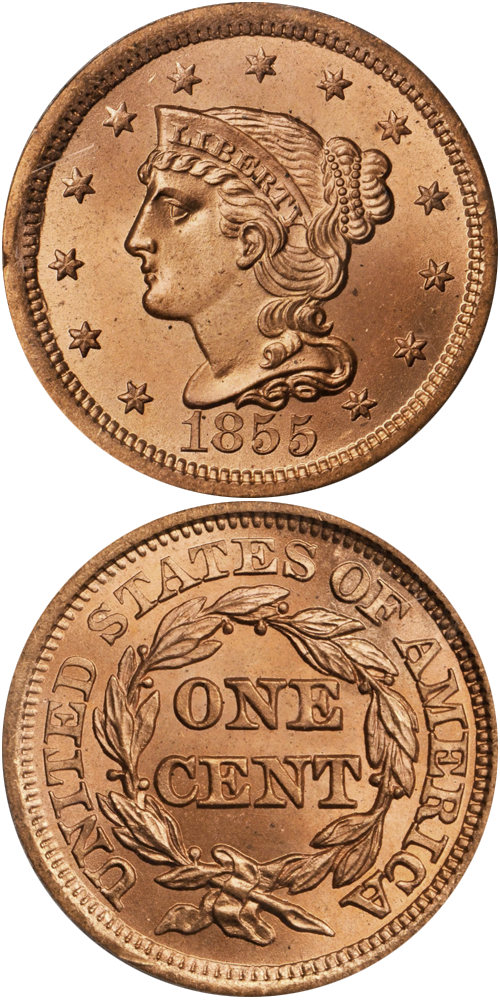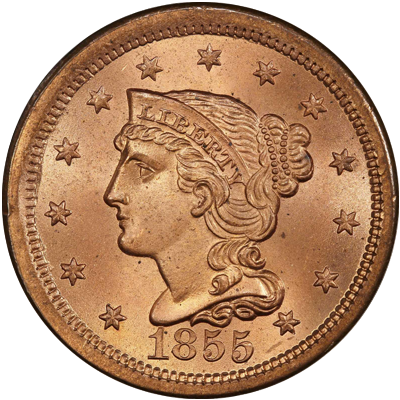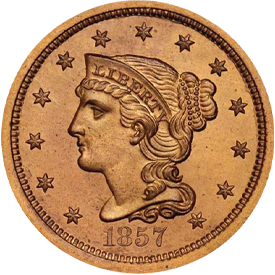Designed by: Christian Gobrecht
Issue Dates: 1839-1857
Composition: Copper
Diameter: 27.5 mm
Weight: 10.88 grams (168 grains)
Edge: Plain
Business Strike Mintage: 70,916,803 (Mintage figure of 70,916,803 does not include the 1839 cents.)
Proof Mintage: Fewer than 1,000
The Braided Hair cent is similar in design to the half cent of the same style and features a compact head of Miss Liberty, her hair strands sharply defined and tied in the back in a bun secured by two beaded cords. A diadem or coronet bears the inscription LIBERTY. Thirteen stars surround, and the date is below. The reverse shows a continuous wreath tied with a ribbon at the bottom, ONE CENT within, with UNITED STATES OF AMERICA around the border. The details on the reverse are slightly different from that used earlier, but the style is the same.
Although there are no rare dates from 1839 through 1857, several varieties are scarce, as is the last date of issue, 1857. By that time the large cent was viewed as being cumbersome for use in everyday transactions, and the Mint desired to replace it with a smaller and more easily handled coin (the result being the Flying Eagle cent subsequently introduced). Typical specimens encountered are apt to range in grade from Very Good to Very Fine, although Extremely Fine coins are plentiful and AU pieces are readily available. Uncirculated coins are also available, although ones in the higher ranges of the category and with full mint color are decidedly elusive.
Further Reading
The final major grouping of cents consists of pieces of the Braided Hair style, a motif first used in 1839. Miss Liberty appears to be more compact, her hair more tightly styled, and her overall appearance more "neat," for want of a better word. Issues from late 1839 through early 1843 feature Miss Liberty's head tilted forward, almost in a falling position.
Later issues of 1843, continuing through the end of the series in 1857, show Miss Liberty aligned in a normal manner. Specimens of this design type are relatively plentiful in grades up through AU. Un circulated examples are scarce among dates in the early 1840s, less scarce in the late 1840s, and relatively plentiful from 1850 through 1856. The last year, 1857, is scarcer, due to the restricted mintage. The typical Uncirculated issue of the 1840s ranges from deep to medium brown to light brown with tinges of mint red. Full bright red cents with original color are rarities. On the other hand, cents from 1850 through 1856, particularly those of the year 1855, are often seen with a generous amount of original mint red, sometimes with full color (save for a few inevitable flyspecks). Uncirculated 1857 cents, when seen, are nearly always brownish-red, not with full blazing original coloration.
As noted earlier, Proofs of the years 1854 through 1857 are seen from time to time. The number minted was in proportion to the growing interest in numismatics at the time. 1857 cents, of which perhaps three dozen Proofs are known (all of the small date variety), are more plentiful than Proof 1856 cents, which in turn are more plentiful than those dated 1855 or 1854.
Varieties among cents of the last two decades include large and small date issues of 1840 and 1842, obverse and reverse style combinations of 1843, and others. The 1844/81 cent resulted from the date being started in an upside-down position on the die by the engraver! After the first two digits were punched, the mistake was realized, and the date was added in the correct orientation. However, traces of the error still can be seen under magnification. The 1851/81 error is similar. Both are related to one of the most fantastic of all errors of this period, the 1858 half dime with the regular date over a complete upside-down date!
These blunders, and others such as differences in date numeral sizes, have been laid at the doorstep of James B. Longacre, chief engraver of the United States Mint, who was criticized for his incompetence by his superiors.
One variety of the 1846 cents has been referred to as a "garbled date," for the numerals have been recut so many times that under a lowpowered glass the date appears as a tangled web of lines and curlicues! Another interesting error is the 1847 cent with a tiny earlier 7 peeking out from beneath the regular-sized digit. At least two dies were made in error this way. A similar variety is found a few years later among Indian cents, the 1867 over small 6 and 7.
Large cents of the 1850s were struck in large numbers, with the exception of the last year, 1857. The year 1855 offers some interesting varieties, including upright 5s in the date and with slanting 5s. It has been theorized that the slanting 5s were a signature of Longacre's engraving, and that other mint employees may have punched the dates in the upright 5s coins. However, this is doubtful, for the same person probably just used two different styles of punches at various times. The 1856 cent also occurs with both varieties of 5. It is interesting to note that 1856 gold dollars have similar differences. The 1855 Knob on Ear variety derives its name from a large lumpy die break appearing on Miss Liberty's ear.
The last year of large cent coinage, 1857, saw a mintage of 333,456 pieces, a sharp reduction from the average mintage of several million coins each year for the preceding decade. Although both large and small date varieties were produced in 1857, the small date varieties are considerably scarcer today. The large date varieties are usually weakly struck, particularly on the reverse. As noted, Uncirculated 1857 cents with full mint color are virtually unknown.
During the 1850s copper costs were rising. It was decided that the old-style large cents were too cumbersome, not to mention the expense of coining such pieces from expensive copper metal. At first it was decided to reduce the size of the large cent. In 1854 and 1855 a number of pattern cents were produced, each of which was smaller and lighter than the regular issue. These were made in fairly large quantities and exist today to the extent of a dozen of pieces of most varieties. Some of these patterns bore the design of a flying eagle, a motif copied from Christian Gobrecht's illustrious silver dollar patterns of the 1836-1839 era. Others bore a Liberty head similar to that used on regular coinage but without obverse stars. Various metallic compositions were tried, including bronze and a copper composition known as "oroide."
By early 1857 the large cent was an anachronism. Although several hundred thousand pieces were produced in that year, by year's end the government was busy redeeming them! From that time through the early 1870s many millions of coppers found their way back to the Treasury for melting.
There is actually one more large cent, although it is not listed in popular references. To learn about it one must go to Dr. J. Hewitt Judd's book, United States Patterns. It is the large cent of 1868.
Sometime in the year 1868 it was decided to make a large cent. Obviously, this piece was created to provide a rarity for sale to collectors, as the small-diameter Indian cent was the official format of the period, and no thought whatever was being given in official or unofficial channels to bringing back the obsolete large cent. These pieces most certainly are not "patterns," but are pieces which were made as specialties for private sale, similar to the 1804 silver dollar, 1884 and 1885 trade dollars, and certain others.








